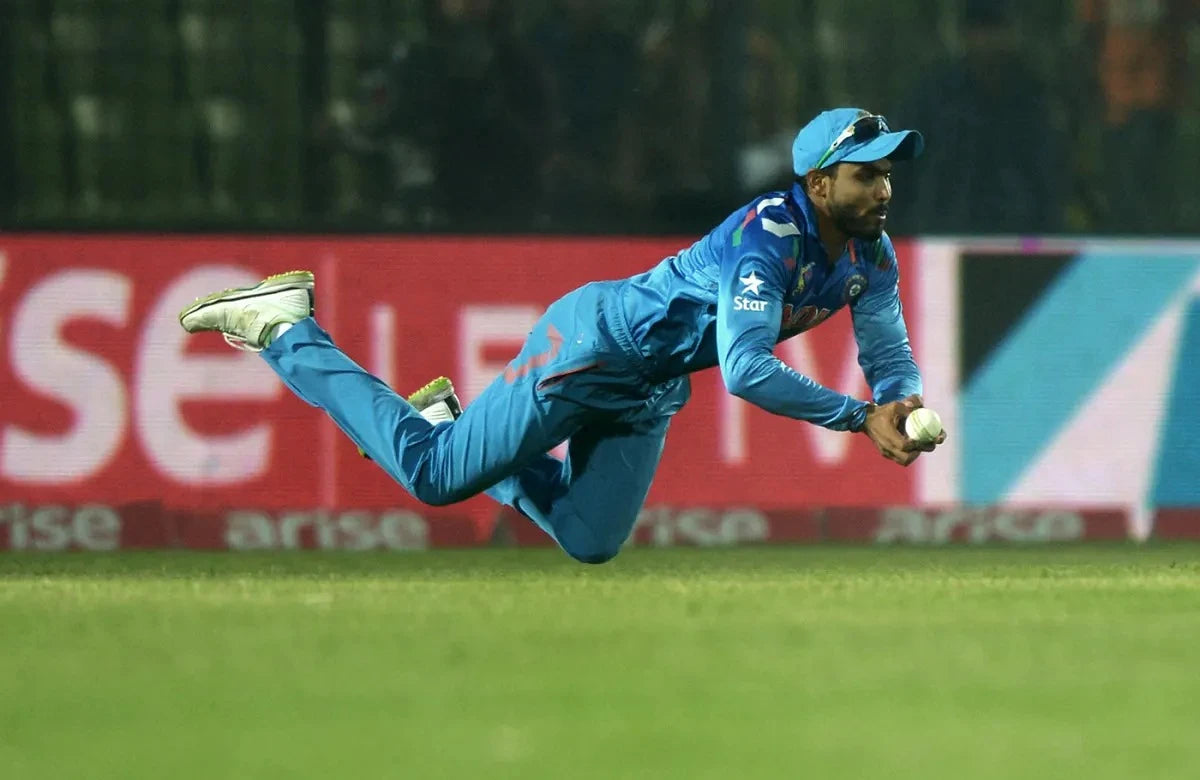Fielders are the unsung heroes of cricket, always reliable and consistently performing at their best. They give it their all, taking spectacular catches, inflicting unreal runouts, stopping the batters from stealing cheeky singles and doubles, and just overall being super-efficient on the field. Their dedication and efficiency on the field make them vital to the team's success. In the history of cricket, some fielders have stood out above the rest, showcasing extraordinary talent and setting benchmarks for excellence.
So, in this article by ZAP, let’s look at some of the best fielders in cricket history who have kept us on the edge of our seats with their incredible fielding ability.
Top 10 Greatest Fielders in Cricket History:
Jonty Rhodes

Jonty Rhodes is without a doubt the greatest fielder in cricket history. Known for his quickness, he could move across the field like a rocket, covering ground with incredible agility. Many experts agree that Rhodes practically reinvented fielding. His natural talent and relentless energy made him a top-class fielder. Rhodes played a key role for South Africa, often fielding at the backward point position, where he made spectacular catches and runouts look fairly easy.
Also Read: Cricket Fielding Techniques
Paul Collingwood

Paul Collingwood was the captain of the England Cricket Team and more than his batting and bowling, it was his fielding which was his best attribute. He is considered not only one of the best fielders in cricket history, but in the entire world. Known for his sharp reflexes and reliable hands, his fielding was consistently outstanding throughout his career.
Keiron Pollard

Kieron Pollard is considered one of the greatest fielders in cricket history. On many occasions, he has taken stunning catches that seem impossible for any other player. Despite having a heavy build, his jumping ability to take flying catches is incredible. One of his most memorable catches was in the 2014 IPL season, where he caught the ball very close to the boundary rope, threw it back within the boundary, then came back to complete the catch with a dive. It was one of the most sensational moments in IPL history. Along with being one of the best fielders in the world, he is also one of the greatest finishing batsmen in cricket history.
Steve Smith

Steve Smith is one of the greatest batsmen ever, no doubt. But his fielding ability is just as great. With exceptionally quick reflexes, his best comes out when he’s positioned at the slips. If you’ve edged one behind and Steve Smith is in the slips, you’ll be better off walking without even looking to see whether he’s grabbed onto the catch, he’s that great of a fielder. Taking blinders and holding onto the easy ones, he’ll make all catches look super easy.
Also Read: Cricket Fielding Positions
Ravindra Jadeja

Ravindra Jadeja is undoubtedly one of the best fielders in the Indian Cricket Team’s history. Jadeja is known for his rare ability to hit the stumps directly from the deep and seldom drops catches. His strong left arm enhances his ability to send the leather ball at bullet speed towards the stumps with pin point accuracy. Fielding in the deep, Jadeja has the safest pair of hands and has very rarely dropped a catch. His presence in the cover point region makes it almost impossible for the ball to get past him. Apart from his fielding, Jadeja is also one of the best all rounders in world cricket right now, who can bat well as a lower order batsman and bowl quality left-arm spin.
You too can channel your inner Jadeja out on the field with the ZAP Catching Bat, which makes every fielding session with your coach at the academy super fun.
Virat Kohli

Virat Kohli is the greatest cricketer of the modern generation across all formats of the game. His batting records in Tests, ODIs and T20Is are second to none. He also currently holds the record for the most centuries in ODI cricket and is also in line to break Sachin Tendulkar’s record of the most runs in cricket history. But when it comes to his fielding, it’s his energy that puts him on the list of the greatest fielders in cricket. He is the player who has redefined the importance of fitness in cricket. His ground fielding is incredible, chasing behind every ball, taking spectacular catches, and inflicting run outs with pin point accuracy from the deep. And the best part, he is the one that keeps everyone on the pitch charged up and is a true inspiration for every player playing alongside him to do better.
Ricky Ponting

Ricky Ponting, known for his safe catching, rocket arm, and incredible accuracy, has run out more batsmen than almost anyone and is considered one of the best fielders in cricket history. He had exceptional athleticism and remarkable skills on the field. Ponting had an uncanny ability to consistently aim sharply at the stumps and make difficult catches seem easy. Additionally, Ponting is also regarded as one of the top three batters of all time. His leadership as Australia's captain, leading the team to two World Cup victories, makes him one of the GOATs of Cricket.
Suresh Raina

Suresh Raina is widely regarded as one of the best fielders in cricket history because of his remarkable energy and enthusiasm on the field. Always encouraging his teammates, Raina showed no hesitation in diving to stop the ball or going all in on difficult catches. Raina's fielding was complemented by his aggressive batting as a left-hander and his occasional off-spin bowling. His ability to clear the field with powerful shots and his electric presence in the inner circle made him a standout player for the Indian Cricket Team and the Chennai Super Kings in the IPL.
Faf du Plessis

Faf du Plessis is one of the best fielders in the world when it comes to the ODI and T20 cricket formats. His reading of the game and his judgement of the path and trajectory of the ball are just too good. He shines when he’s in the mid on mid off fielding positions, not hesitating in going for a long dive to complete a catch, or running behind to take a difficult one, he puts his all when he’s on the pitch. Along with being one of the best fielders in cricket, he’s also a very experienced batter and a captain, which have made him an asset for the Royal Challengers Bangalore in the IPL in recent years.
AB de Villiers

The third South African on this list, AB de Villiers, was super versatile on the field. Originally a wicketkeeper, he transformed his roles to become a full time fielder and consistently wowed fans with his performances on the field. His speed, intensity, and sharp reflexes were extraordinary. AB's knack for effortlessly completing catches, executing and getting quick run-outs make him one of the greats on this list.
FAQ:
Which player has taken the most catches in cricket history?
Mahela Jayavardene from Sri Lanka holds the record for the most catches taken in cricket history with 440 catches in 652 matches.
Who is India's best fielder ever?
India has produced some excellent fielders like Virat Kohli, Suresh Raina, Yuvraj Singh, Mohammad Kaif and many others. Rahul Dravid is the one who holds the record of most catches taken for the Indian team with 334 catches in 509 matches. But putting all of these aside, when it comes to the greatest fielder from India, it has to be Ravindra Jadeja. His flawless fielding, his throws, and his runouts make him the best ever from India.



Share:
Which player has the Most Catches in Cricket History?
What is Net Run Rate (NRR) in Cricket and how to Calculate it?